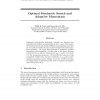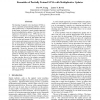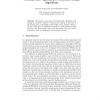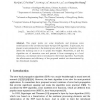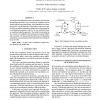MVA
2002
14 years 2 months ago
2002
2 Related Works Gaussian mixtures are often used for data modeling in many real-time applications such as video background modeling and speaker direction tracking. The real-time a...
NIPS
1993
14 years 3 months ago
1993
Stochastic optimization algorithms typically use learning rate schedules that behave asymptotically as (t) = 0=t. The ensemble dynamics (Leen and Moody, 1993) for such algorithms ...
ICMLA
2003
14 years 3 months ago
2003
This work represents the first step towards a task library system in the reinforcement learning domain. Task libraries could be useful in speeding up the learning of new tasks th...
IJCAI
2007
14 years 3 months ago
2007
The training of support vector machines (SVM) involves a quadratic programming problem, which is often optimized by a complicated numerical solver. In this paper, we propose a muc...
ECML
2006
Springer
14 years 6 months ago
2006
Springer
We present a new class of perceptron-like algorithms with margin in which the "effective" learning rate, defined as the ratio of the learning rate to the length of the we...
EUROCOLT
1999
Springer
14 years 6 months ago
1999
Springer
Many settings of unsupervised learning can be viewed as quantization problems — the minimization of the expected quantization error subject to some restrictions. This allows the ...
ICIC
2005
Springer
14 years 8 months ago
2005
Springer
This paper points out some drawbacks and proposes some modifications to the conventional layer-by-layer BP algorithm. In particular, we present a new perspective to the learning ra...
GECCO
2007
Springer
14 years 8 months ago
2007
Springer
We analyze generalization and learning in XCS with gradient descent. At first, we show that the addition of gradient in XCS may slow down learning because it indirectly decreases...
ICASSP
2007
IEEE
14 years 8 months ago
2007
IEEE
One of the main dif culties in echo cancellation is the fact that the learning rate needs to vary according to conditions such as double-talk and echo path change. Several methods...
CEC
2009
IEEE
14 years 9 months ago
2009
IEEE
— The population-based incremental learning (PBIL) algorithm is a combination of evolutionary optimization and competitive learning. Recently, the PBIL algorithm has been applied...

